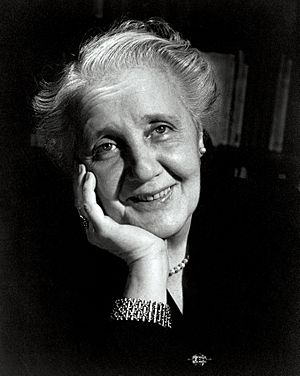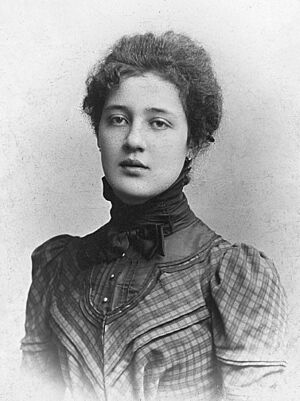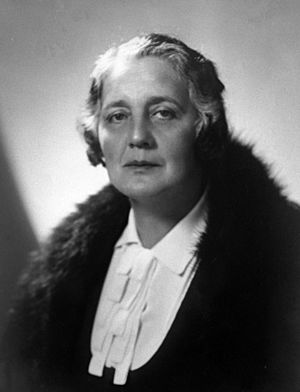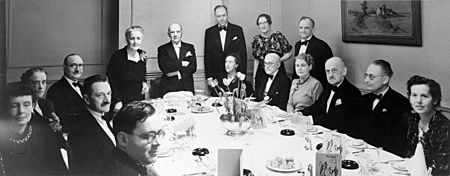Melanie Klein facts for kids
Quick facts for kids
Melanie Klein
|
|
|---|---|

Melanie Klein in 1952
|
|
| Born |
Melanie Reizes
30 March 1882 |
| Died | 22 September 1960 (aged 78) London, England
|
| Known for | Therapeutic techniques for children Coining the term 'reparation' Klein's theory splitting Projective identification |
| Children | Melitta Schmideberg |
| Scientific career | |
| Fields | Psychoanalysis |
| Influences | Sigmund Freud Karl Abraham |
| Influenced |
|
Melanie Klein (born Melanie Reizes; 30 March 1882 – 22 September 1960) was an important Austrian-British writer and psychoanalyst. She is famous for her work with children. She helped develop a way of understanding how people relate to others, called object relations theory.
Klein believed that even very young babies have worries. These worries help shape their unconscious mind. This means they start to see the world as having "good" and "bad" parts. How a child learns to deal with these ideas depends on their own personality and how they are cared for. This early learning can affect how a person feels and acts later in life.
Contents
Melanie Klein's Life Story
Melanie Klein was born into a Jewish family in Vienna, Austria. She was the youngest of four children. Her parents were Moriz, a doctor, and Libussa Reizes. Melanie went to a school called a Gymnasium. She had planned to study medicine. However, her family lost their money, so she had to change her plans.
When she was 21, she married Arthur Klein, a chemist. Soon after, they had their first child, Melitta. Her son Hans was born in 1907, and Erich in 1914. Melanie had clinical depression, and her pregnancies were very hard on her. Her marriage was also unhappy. These things led her to seek help.
In 1910, her family moved to Budapest. There, Klein started therapy with a psychoanalyst named Sándor Ferenczi. During this time, Klein became very interested in studying psychoanalysis herself.
Developing Play Therapy
Ferenczi encouraged Klein to start her studies by watching her own children. At that time, there wasn't much information about psychoanalysis for children. Klein saw this as a chance to create something new. She developed her "play technique."
Klein believed that children's play shows what they are thinking and feeling deep inside, even if they don't know it. She thought that playing with toys could be understood and analyzed. This was similar to how adults' dreams are analyzed in therapy. Her research helped create what we now call play therapy.
In 1921, her marriage ended, and Klein moved to Berlin. She joined the Berlin Psycho-Analytic Society. There, she learned from Karl Abraham. Abraham supported her new ideas about working with children. However, many others in Berlin did not support her or her ideas.
It was hard for Klein because she was a divorced woman. She also didn't have a college degree, which was unusual in a field mostly led by male doctors. But her early work still had a big impact. It helped shape how psychoanalysis developed, especially in Great Britain.
Discussions and Debates
Klein's ideas about how humans develop and how they protect themselves from difficult feelings were new. They were different from Sigmund Freud's ideas. This caused many debates in the world of developmental psychology. Around the same time, Anna Freud (Sigmund Freud's daughter) was also sharing her ideas.
Melanie Klein and Anna Freud became rivals. Their followers had long debates, known as the 'controversial discussions.' These discussions led to the British Psychoanalytical Society splitting into three groups. There was a Kleinian group, a Freudian group, and an Independent group. Eventually, they agreed to teach both approaches for child analysis.
Melanie Klein's Contributions to Psychoanalysis
Melanie Klein was one of the first people to use traditional psychoanalysis with young children. She was very creative in her methods. For example, she used toys to work with children. She also had new ideas about how babies develop. Klein earned respect from experts and created a very important training program in psychoanalysis.
By watching and understanding how children played and interacted, Klein added to Freud's ideas about the unconscious mind. She explored the deep, hidden parts of a baby's mind. This helped her understand how the superego (the part of our mind that tells us right from wrong) starts to form very early in life.
Understanding Babies
Klein started talking about how important it is to watch babies in 1935. She gave a public talk about weaning (when babies stop drinking milk).
Klein believed that the connection between a mother and her baby is about more than just feeding. She thought the mother's feelings and bond with her baby are very important. Klein came to this idea by watching herself and other mothers she knew.
She saw how babies are interested in their mothers' faces and the touch of their hands. This connection grows very soon after birth. Klein noticed that as early as two months old, babies show interest in their mothers beyond just needing food. She observed that babies often smile at their mothers and cuddle close. How a baby reacts to their mother's feelings and the love they show creates a special bond. This is what she called an "object relation."
Klein also said that babies understand that their achievements, like crawling or walking, make their parents happy. She observed that a baby wants to make their mother feel love and joy with their achievements. Klein noted that a baby learns their smile makes their mother happy and gets them attention. They also learn that smiling might work better than crying to get what they want.
The "Apathetic" Baby
Klein also talked about babies who seem "apathetic" or uninterested. She said it's easy to think a baby who eats well and cries little is a happy baby. But as they grow, some of these easy-going babies are not truly happy. Their lack of crying might be a sign of a deeper lack of interest. It's hard to know what a young child is feeling without understanding their complex emotions.
When these babies are watched over time, they often show difficulties later. They might be shy around people. They might not be interested in the world around them, playing, or learning. They might be slow to crawl or walk because they don't have much motivation. As they grow, they often show signs of anxiety or other emotional problems.
Object Relations Theory
Melanie Klein is known as one of the main founders of object relations theory. This idea in psychoanalysis suggests that everyone has an inner world of relationships. These relationships are mostly unconscious. They are not just about the people around us, but how we see and feel about those people inside ourselves.
Object relations theory focuses on how we interact with others. It also looks at how these interactions become part of our inner thoughts and feelings. Then, it explores how these "internalized object relations" affect our minds. The word "object" here means a person or thing that we feel strong emotions about, like fear, desire, or envy. The "object" and the "subject" (the person feeling the emotions) are seen separately. This helps therapists understand and help with unmet needs.
Klein's approach was different from Anna Freud's. Klein looked at how people relate to each other in their minds. In the mid-1920s, Klein had a different idea about how we first deal with difficult feelings. She thought it was by "expelling" them, while Freud thought it was by "repressing" them. Klein believed that babies could relate to their mothers from birth. She thought babies saw their mothers as either "good" or "bad." These ideas then became part of the baby's inner world. Because of this, Klein believed that a baby's "ego" (their sense of self) exists from birth. This allows babies to connect with others very early in life.
Influence on Feminism
In Dorothy Dinnerstein’s book The Mermaid and the Minotaur (1976), she used some of Melanie Klein's ideas. Dinnerstein argued that sexism and aggression happen because women are usually the only ones who care for babies and children. To fix this, Dinnerstein suggested that men and women should share childcare equally. This book became very important in the second-wave feminism movement in the U.S. It was later translated into seven languages.
Some feminists have also criticized Klein's work. They pointed out that Klein sometimes assumed a natural link between sex, gender, and desire. They also felt her descriptions of gender were sometimes too simple. They thought she favored heterosexual relationships too much.
See also
 In Spanish: Melanie Klein para niños
In Spanish: Melanie Klein para niños
- Edna O'Shaughnessy
- Ignacio Matte Blanco
- Joseph J. Sandler
- Klein's theory splitting
- Nina Searl
- Reparation (psychoanalysis)
- Object relations theory
- Symbolic equation





